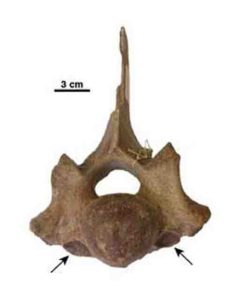
Researchers from the Naturalis Biodiversity Center in Leiden examined woolly rhino and modern rhino neck vertebrae from several European and American museum collections and noticed that the remains of woolly rhinos from the North Sea often possess a ‘cervical’ (neck) rib — in contrast to modern rhinos.
The study, published in the open access journal PeerJ today, reports on the incidence of abnormal cervical vertebrae in woolly rhinos, which strongly suggests a vulnerable condition in the species. Given the considerable birth defects that are associated with this condition, the researchers argue it is very possible that developmental abnormalities contributed towards the eventual extinction of these late Pleistocene rhinos.
In modern animals, the presence of a ‘cervical rib’ (a rib attached to a cervical vertebra) is an unusual event, and is cause for further investigation. Though the rib itself is relatively harmless, this condition is often associated with inbreeding and adverse environmental conditions during pregnancy.
Frietson Galis, one of the authors of the peer-reviewed study, found a remarkably high percentage of these neck ribs in the woolly mammoth, published in a previous study.
“This aroused our curiosity to also check the woolly rhino, a species that, like the woolly mammoth lived during the late Pleistocene and similarly died out,” said Alexandra van der Geer, one of the authors of the study. “The woolly rhino bones were all dredged from the North Sea and river deltas in the Netherlands. We knew these were just about the last rhinos living there, so we suspected something could be wrong here as well. Our work now shows that there was indeed a problem in the woolly rhino population.”
The absence of cervical ribs in the modern sample is by no means evidence that rhino populations today are healthy. Museum collections are based on rhino specimens that were collected at least five decades ago. Rhinoceros numbers are dwindling extremely fast, especially the last two decades, resulting in near extinction for some species and the total extinction of the western black rhinoceros.
“Our study suggests that monitoring the health of the vertebrae in rhinos has the potential to timely detect developmental errors that indicate the level of extinction risk,” said Frietson Galis.
Reference:
van der Geer and Galis. High incidence of cervical ribs indicates vulnerable condition in Late Pleistocene woolly rhinoceroses. PeerJ, 2017 DOI: 10.7717/peerj.3684
Note: The above post is reprinted from materials provided by PeerJ.










